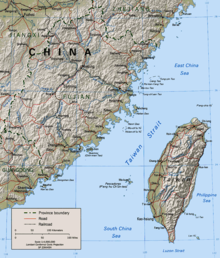- Taiwan Strait
-
Taiwan Strait 
A map showing the Taiwan Strait Area Traditional Chinese 臺灣海峽 or 台灣海峽 Simplified Chinese 台湾海峡 Hokkien POJ Tâi-ôan Hái-kiap Transcriptions Hakka - Romanization Thòi-vân Hói-hia̍p Mandarin - Hanyu Pinyin Táiwān Hǎixiá Min - Hokkien POJ Tâi-ôan Hái-kiap Wu - Romanization de平uae平 he上yah入 Cantonese (Yue) - Jyutping toi4waan1 hoi2haap3 Abbreviated as Traditional Chinese 臺海 or 台海 Simplified Chinese 台海 Transcriptions Hakka - Romanization Thòihói Mandarin - Hanyu Pinyin Táihǎi Min - Hokkien POJ Tâihái Wu - Romanization de平he上 Cantonese (Yue) - Jyutping toi4hoi2 The Taiwan Strait or Formosa Strait, formerly known as the Black Ditch,[1] is a 180-km-wide (111.85-mile-wide) strait separating Mainland China and Taiwan. The strait is part of the South China Sea and connects to East China Sea to the northeast. The narrowest part is 130 km (81 mi) wide.[2]
Contents
Geography
Fujian province in mainland China is to the west of the strait, while important islands like Kinmen, Xiamen Island, Pingtan Island, and the Matsu Islands lie just off the coast. To the east are the west coasts of Taiwan and Penghu. The island fishermen[specify] use the strait as a fishing resource. The Min and Jiulong Rivers empty into the strait.
There have been discussions about the strategic importance of the Taiwan Strait. Some Japanese politicians claimed that the Taiwan Strait is an essential sea route for oil shipment from the Middle East via the Malacca Strait to Japan.[3] However, some have argued that this is merely an excuse for intervention since the sea lane east of Taiwan is even shorter [4]
History
The Strait has been the theatre for several military confrontations between Mainland China and Taiwan since the last days of the Chinese Civil War in 1949 when the Kuomintang (KMT) forces led by Generalissimo Chiang Kai-shek retreated across the Strait and relocated its government on its final stronghold of Taiwan. A theoretical median maritime border known as the cross-strait median (海峽中線) also exist on the water to prevent certain transportation from passing.[5]
As part of the People's Republic of China's National Expressway Plan, a tunnel or possibly a bridge, was proposed in 2005 to link the cities of Fuzhou, Fujian, China with Taipei, Taiwan across the strait (Map[6]). If such an extreme construction would ever be built, it would by far exceed the length of any man-made tunnel in the world today. Engineers in Beijing state that a tunnel is technically feasible. However, the Republic of China government had refused to open direct links out of concern for the island's security and in fear that by doing so it would have to recognize the People's Republic of China's one-China policy.[7][8]
See also
- Cross-Strait relations
- Battle of Kuningtou
- First Taiwan Strait Crisis
- Second Taiwan Strait Crisis
- Third Taiwan Strait Crisis
- Political status of Taiwan
- Taiwan Strait Tunnel Project
- China Airlines flight 611
- Luzon Strait
Notes
- ^ "Calligraphy in Taiwan". Government Information Office, Republic of China (Taiwan). http://www.gio.gov.tw/taiwan-website/5-gp/culture/calligraphy/index.html. Retrieved 2011-03-04. "Later on as mainland China suffered under a series of rebellions and invasions, thousands of farmers from the coastal provinces of Fujian and Guangdong risked their lives to cross the dangerous “Black Ditch” (today’s Taiwan Strait) and settled into agrarian lifestyles on Taiwan island."
- ^ "Geography". Government Information Office. http://www.gio.gov.tw/taiwan-website/5-gp/yearbook/2001/chpt01-1.htm. Retrieved 2011-01-23.
- ^ http://yaleglobal.yale.edu/content/japan-dips-its-toe-taiwan-strait
- ^ http://sun-bin.blogspot.com/2005/10/myth-of-strategic-location-of-taiwan.html
- ^ Chinareviewnews.com. "Chinareviewnews.com." 大公報文章:“海峽中線”應該廢除. Retrieved on 15 July 2009.
- ^ China, China (2008-12-01). "Medium to Long Term Rail Network Plan for PRC". China Rail Department (China). http://www.czstation.net/upimg/allimg/081208/1304390.jpg. Retrieved 2010-05-24.
- ^ Wu Zhong (January 14, 2005). "Mainland to triple highway network". The Standard. http://www.thestandard.com.hk/stdn/std/Front_Page/GA14Aa01.html. Retrieved 13 December 2007.
- ^ Gittings, John (2002-04-08). "Plans unveiled in China for Taiwan tunnel". The Guardian (London). http://www.guardian.co.uk/world/2002/apr/08/china.johngittings. Retrieved 2010-05-24.
Further reading
- Bush, R. & O'Hanlon, M. (2007). A War Like No Other: The Truth About China's Challenge to America. Wiley. ISBN 0471986771
- Bush, R. (2006). Untying the Knot: Making Peace in the Taiwan Strait. Brookings Institution Press. ISBN 0815712901
- Carpenter, T. (2006). America's Coming War with China: A Collision Course over Taiwan. Palgrave Macmillan. ISBN 1403968411
- Cole, B. (2006). Taiwan's Security: History and Prospects. Routledge. ISBN 0415365813
- Copper, J. (2006). Playing with Fire: The Looming War with China over Taiwan. Praeger Security International General Interest. ISBN 0275988880
- Federation of American Scientists et al. (2006). Chinese Nuclear Forces and U.S. Nuclear War Planning
- Gill, B. (2007). Rising Star: China's New Security Diplomacy. Brookings Institution Press. ISBN 0815731469
- Shirk, S. (2007). China: Fragile Superpower: How China's Internal Politics Could Derail Its Peaceful Rise. Oxford University Press. ISBN 0195306090
- Tsang, S. (2006). If China Attacks Taiwan: Military Strategy, Politics and Economics. Routledge. ISBN 0415407850
- Tucker, N.B. (2005). Dangerous Strait: the U.S.-Taiwan-China Crisis. Columbia University Press. ISBN 0231135645
- Turin, D. (2010). The Taiwan Strait: From Civil War to Status Quo. Student Pulse. Vol 2., No. 6. The Taiwan Strait: From Civil War to Status Quo
- Wallace Thies, and Patrick Bratton, “When Governments Collide in the Taiwan Strait,” Journal of Strategic Studies, 27, no. 4 (December 2004), 556-84.
Straits of China Qiongzhou Strait • Taiwan StraitCoordinates: 24°48′40″N 119°55′42″E / 24.81111°N 119.92833°E
Categories:- South China Sea
- Straits of Asia
- Straits of Taiwan
- Straits of China
- International straits
Wikimedia Foundation. 2010.
